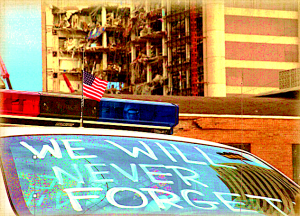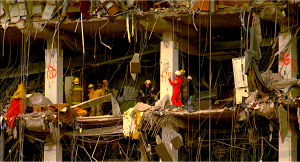
Skip and Aspen.
Among the many heroes who emerged from the ashes of the Oklahoma City bombing in April, 1995, were three Golden Retrievers from Miami, Florida, with the unlikely names of Aspen, Maggie, and Brandee.
The dogs all belonged to the Metro Dade County Fire Department and were also a part of the FEMA Task Force 1 from Miami. All three were trained search-and-rescue dogs, and all performed brilliantly.
I met all of them and was instantly smitten. I fell in love on the spot with Aspen.
The dogs of gold
Fire departments around the country use Golden Retrievers, as well as a few other breeds, to locate missing children and to find the bodies of victims often buried under piles of rubble.
Such was the case when domestic terrorists blew apart the Alfred P. Murrah Federal Building on the morning of April 19, 1995.
These and other rescue dogs sniffed, climbed, and dug their way through the tons of debris left in the wake of that bombing. Over eight days, Aspen, Maggie, and Brandee scampered unleashed over tall, dangerous rubble piles and into tight, hidden voids that led to canyons beneath the cluttered surface to find many bodies that human searchers could not find themselves.
Risky work
Their work was dangerous, because parts of the 9-story building were still standing precariously, as torched and bent steel girders and cables, that could break at any minute, were the only things keeping the remaining structure from caving in on the rubble below.
All the bent, twisted, and fallen pieces of the Murrah Building were very much like a giant Jenga tower. Knocking down or even jostling the wrong piece could cause the whole remaining structure to collapse on anyone — human or canine — below.
Covering the story
I was a journalist covering this search-and-rescue operation, and to say I was impressed with what I saw and heard about these dogs,
would be a gross understatement. They were wonderful.
The first fireman I interviewed was Miami’s Skip Fernandez, who was sitting on a curb across the street from the building’s carcass. A beautiful brown-eyed Golden Retriever named Aspen was sitting between his splayed-out legs. Both of them looked very tired and very sad.
Skip looked like he wanted to talk, so I sat down to listen. Aspen never took her eyes off me, even when I took her picture.
Unique traits
“Golden Retrievers have a natural propensity to be drawn to people,” Skip said. “And that is highly important, because these dogs have to have an affinity for people. It must be strong enough for them to want to seek people out and help them if possible.”
Skip and Aspen had just come off a 12-hour shift on the Murrah rubble pile, searching for any signs of life — or any dead bodies. There would be plenty of the latter before the search was over: 168 perished in this bombing. More than 600 were injured, many severely.
The 2-year-old Aspen was the embodiment of a well-trained rescue dog who had the natural instincts and traits needed for the job. And, when off-duty, she served another purpose as a great stress-reliever for many of the human first-responders who worked the disaster scene.
Switching roles
Aspen and the other dogs transitioned quickly to the role of therapy dogs for those searchers traumatized by all that they saw and experienced on the remains of the Murrah Building.
“The crews really enjoy these dogs and play around with them a lot after work,” Skip said. “The dogs help take the guys’ minds off what they have just seen in the rubble pile. And the dogs love those playtimes, too.”
For Skip himself, Aspen represented a new love in his life, and she replaced a painful loss.
“I lost a Golden Retriever to cancer last year, and it was just like losing one of my daughters,” he remembered. “Her name was Sierra, and she was 11 when she died. Now I have Aspen, and I love her. She lives with me and, when she leaves the department, she will be retired to my backyard.”
National recruiting
The dogs are recruited from all parts of the country. Aspen came as a puppy from the Sunjoie Kennels in Topanga, California. Skip said the fire department likes to get the dogs as puppies and take them through a process of bonding, socialization, and training.
Specifically, fire departments look for two inborn traits or drives: These are what they call the “prey drive” and the “play drive.”
“The dogs have to be natural hunters and love hunting,” he said. “But they also have to love to play, because that is the reward we give them for doing a good job.”
From rescue to romping
In Oklahoma City, when the dogs’ 12-hour shifts were over,  they would be taken to the nearby Myriad Botanical Gardens. There, for 90 minutes, they could run, chased balls or frisbees, play with firemen, roll in the grass and generally enjoy themselves.
they would be taken to the nearby Myriad Botanical Gardens. There, for 90 minutes, they could run, chased balls or frisbees, play with firemen, roll in the grass and generally enjoy themselves.
Fernandez called it, “Their de-stressor time.”
Then the dogs would be taken to the Myriad Convention Center where the firemen were housed, and there they would get a well-deserved sleep until it was time to head back to the rubble pile for more work.
“These dogs actually turned hours into minutes,” Fernandez said. “And they located many victims we would have never found otherwise.”
Training is vital
Despite the dangers from falling debris and precarious footing on the rubble, none of them were injured or suffered any serious cuts. He attributed much of that to the dogs’ exhaustive training in working under simulated conditions.
Asked how Aspen performed, Skip beamed and said, “She got an A!”
Metro Dade Fire Department is one of a network of departments around the country who contribute their human  and canine first responders to the Federal Emergency Management Administration (FEMA). When disasters occur anywhere in the country, they can be called into action.
and canine first responders to the Federal Emergency Management Administration (FEMA). When disasters occur anywhere in the country, they can be called into action.
Eleven FEMA teams like Skip’s came to Oklahoma City instantly for a two-week period of search and rescue. Most of them brought dogs like Aspen. Although Golden Retrievers make up only one-third of Metro Dade’s K-9 Rescue Teams (the other nine are Labs, German Shepherds, and Malimois) they made up 100 percent of the three dogs that came to Oklahoma City. All were females.
An ironic mission?
It seems somehow ironic that gentle dogs like Aspen, Maggie, and Brandee who have such a natural love for people — especially children — are the ones who are often assigned to locating the lost and dead ones. And yet, maybe it is only right that they do.
Still, there was an undeniable sadness in Aspen’s eyes on the morning when we first met. She seemed to know exactly what was going on.
I am a writer, college professor, and author of several nonfiction books, including three on the decade of the 1960s. Several wonderful essays of gifted Retrospect authors appear in my book, "Daily Life in the 1960s."




Thanx for this wonderful story Jim.
I knew you covered the Oklahoma City bombing but not about your interaction with these amazing dogs.
I’m sharing your story with my friend Connie who works with service dogs and for years had a beloved guide dog in the family for her husband Paul who was blind.
Bless all these heroic dogs and their trainers.
It was a memorable experience, Dana!
This was an unusually informative Retro story for me, and i thank you for it. I have heard of rescue dogs but it seems I never even knew what questions I had about them. In this narrative, you answered a whole bunch of questions I wish I had asked. And you brought me closer to some people, an activity, and a dog–that I had only viewed from a great distance. Good journalism. Good writing.
Thank you, Dale. I’ll never forget Aspen!
Great story about how dogs can be trained to do important work. They make amazing companions for the disabled.
Thank you Dave for such a wonderful introduction to these dogs and their work. I will carry these stories forever. Too bad, or not, my Springer Spaniel cannot read or pay attention.
Thanks, Richard. They are amazing dogs.
Thanks for the moving story. I had heard that it is very stressful for rescue dogs to only find dead bodies, and that sometimes the handlers would arrange for them to “find” someone alive. Such remarkable dogs, capable of feats we humans can’t do, and such a comfort too. They certainly deserve all the love and respect we can return. Sometimes I would see therapy dogs brought into longterm care homes or immunization clinics, and though the primary purpose was for the patients, the staff enjoyed the de-stressing, including me. I imagined the dogs got some enjoyment as well.
Thanks, Khati. You’re right: these dogs serve more than one purpose!